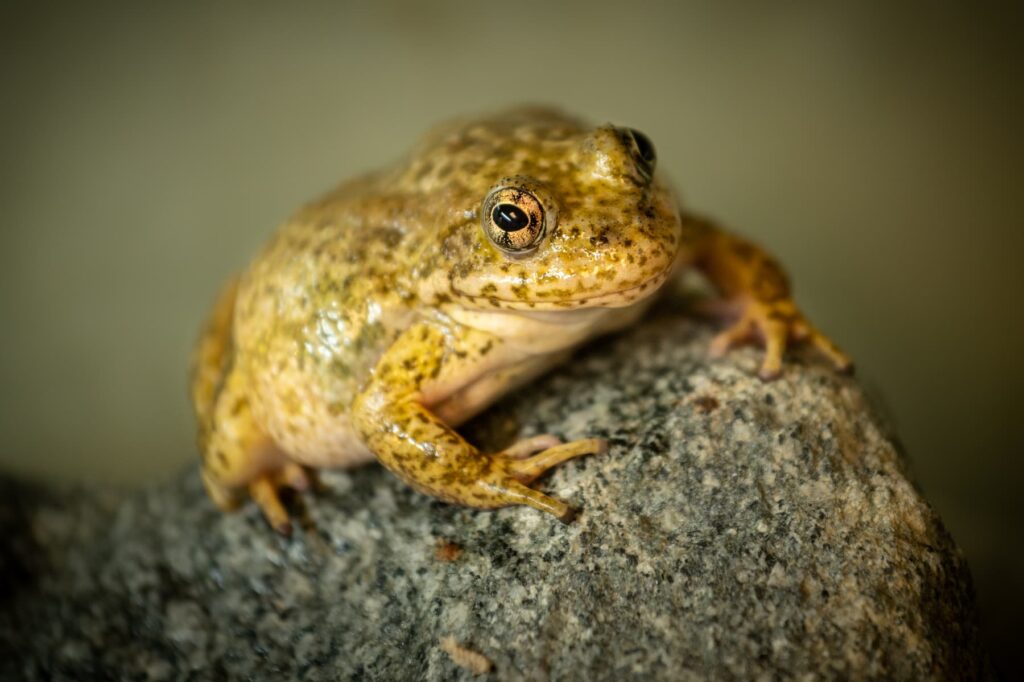Approximately 170 Southern Mountain Yellow-Legged Frogs Were Translocated To The San Gabriel Mountains on Aug. 29 and 30

Approximately 170 Endangered southern mountain yellow-legged frogs (Rana muscosa) were released into their native habitat in the San Gabriel Mountains on Aug. 29 and 30, 2023.
Animal care staff from the Los Angeles Zoo joined conservationists from the U.S. Geological Survey (USGS) to an undisclosed site to conduct the release. A majority of the tadpoles were hatched at the Los Angeles Zoo and cared for by the Aquarium of the Pacific and Santa Ana Zoo. Approximately 90 frogs were raised by the Aquarium of the Pacific and approximately 50 were raised by the Santa Ana Zoo. The remaining frogs released this week came from a group rescued from the 2020 Bobcat Fire and cared for by the Aquarium of the Pacific.
“This release is momentous for the L.A. Zoo as it marks another key milestone for our southern mountain yellow-legged frog breeding program,” said Ian Recchio, Curator of Reptiles and Amphibians, Los Angeles Zoo. “We are proud to be part of this long-running recovery effort with the USGS and partners. We hope Angelenos will see this effort in their own backyard and think about actions they can take to help conserve wildlife.”
The recovery program was established to bolster populations in the wild in an effort to save this species from extinction. Frogs bred at the Los Angeles Zoo are hatched and raised with the help of zoo and aquarium partners to ensure their development beyond their most vulnerable state. Once they are mature enough, they are released into natural habitats giving them a better chance of avoiding predation and other threats. Since 2007, when the breeding colony was established at the L.A. Zoo, nearly 6,000 zoo-bred offspring have been released into the San Gabriel Mountains and surrounding habitats.
The Southern Mountain Yellow-Legged Frog Recovery Program is a collaborative endeavor, under the leadership of the USGS, formed in 2006 between the Los Angeles Zoo, the San Diego Zoo Wildlife Alliance, Omaha’s Henry Doorly Zoo and Aquarium, U.S. Forest Service, U.S. Fish and Wildlife Service, and the California Department of Fish and Wildlife. To help with managed breeding efforts, the L.A. Zoo designed a bio-secure amphibian breeding room to create a quiet, temperature-controlled environment for the tadpoles being brought to the Zoo’s captive breeding program. Built by Zoo animal care and aquarist staff, the room is equipped with life support and water quality technology to provide the most optimal conditions for this sensitive species of frog.
After this release, the Aquarium of the Pacific is continuing to care for more tadpoles behind the scenes to raise them from that vulnerable stage up to froglets for future release. The Santa Ana Zoo currently cares for forty-one juvenile frogs. Last year, 188 of these amphibians raised at the Aquarium and twenty-five from the Santa Ana Zoo were released to the wild.
“Releases of endangered species are exciting moments, but what makes this release extra special is that these frogs are from a genetically under-represented population, which can help to further increase the chances of this species’ survival,” said Brett Long, Director of Mammals and Birds, Aquarium of the Pacific.
“It’s been an honor working with our recovery program partners to help ensure the survival of the mountain yellow-legged frog,” said Amber Suto, Education Specialist, Santa Ana Zoo. “They used to be one of the most common amphibians in our mountains, and we hope to see them thriving in their natural habitat again one day. Our goal is to establish at least twenty stable populations in the wild with at least fifty frogs each to ensure this species continues on for the next one hundred years. This recent release was one more step towards making that happen.
The southern mountain yellow-legged frog are classified as Endangered by the International Union for Conservation of Nature (IUCN). This species lives in perennial streams in select areas of the San Gabriel, San Bernardino, and San Jacinto Mountains. They are a medium-sized amphibian, measuring about 1.5 to 3.25 inches on average. Adult frogs are a mix of brown and yellow coloring but can also be grey, red, or greenish-brown, usually with dark spots or splotches, called cryptic coloration. These spots can look like lichen or moss and make the frog appear camouflaged. The belly and underside of the back legs, and sometimes the front legs, are yellow or light-orange. This gives the frog part of its common name, “yellow-legged.”
The public can view the southern mountain yellow-legged frog at the L.A. Zoo’s seasonal habitat inside its Living Amphibian, Invertebrate, and Reptile exhibit (LAIR). The habitat is open to the public during regular Zoo hours between May and November, after which the frogs move to the Zoo’s bio-secure amphibian breeding facility for the breeding season.
